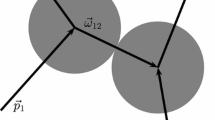Abstract
We provide a dynamical proof of the second law of thermodynamics, along the lines of an argument of Penrose and Gibbs, making crucial use of the upper semicontinuity of the mean entropy proved by Robinson and Ruelle and Lanford and Robinson. An example is provided by a class of models of quantum spin systems introduced by Emch and Radin. Consequences regarding irreversibility and the time arrow, as well as possible extensions to quantum continuous systems, are discussed.
Similar content being viewed by others
References
Bratelli, O., Robinson, D.W.: Operator Algebras and Quantum Statistical Mechanics I. Springer, Berlin (1987)
Bratelli, O., Robinson, D.W.: Operator Algebras and Quantum Statistical Mechanics II, 2nd edn. Springer, Berlin (1997)
Carruthers, G.R.: Atomic and molecular hydrogen in interstellar space. Sp. Sci. Rev. 10, 459 (1970)
Emch, G.G.: Non-markovian model for the approach to equilibrium. J. Math. Phys. 7, 1198 (1966)
Emch, G.G.: Generalized K flows. Commun. Math. Phys. 49, 191–215 (1976)
Fannes, M.: A continuity property of the entropy density for quantum lattice systems. Commun. Math. Phys. 31, 291–294 (1973)
Froehlich, J.: A brief review of the ET.H approach to quantum mechanics. arXiv:1905.06603 (2019)
Goldstein, S., Lebowitz, J.L., Tumulka, R., Zanghi, N.: Gibbs and Boltzmann entropy in classical and quantum mechanics. arXiv:1903.11870 (2019 )
Haag, R.: On the sharpness of localization of individual events in space and time. Found. Phys. 43, 1295–1313 (2014)
Harrison, E.R.: Cosmology. Cambridge University Press, Cambridge (1981)
Jäkel, C., Narnhofer, H., Wreszinski, W.F.: On the mixing property for a class of states of relativistic quantum fields. J. Math. Phys. 51, 052703 (2010)
Lowe, I., Norberg, R.E.: Free induction decays in solids. Phys. Rev. 107, 46 (1957)
Lebowitz, J.L., Penrose, O.: Modern ergodic theory. Phys. Today 26, 23–29 (1973)
Lanford, O., Robinson, D.W.: Mean entropy of states in quantum statistical mechanics. J. Math. Phys. 9, 1120 (1968)
Lieb, E.H., Robinson, D.W.: The finite group velocity of quantum spin systems. Commun. Math. Phys. 28, 251 (1972)
Lieb, E.H., Yngvason, J.: The physics and mathematics of the second law of thermodynamics. Phys. Rep. 310, 1–96 (1999)
Lieb, E., Yngvason, J.: The entropy concept for non-equilibrium states. Proc. R. Soc. A 469, 20130408 (2013)
Nachtergaele, B., Sims, R., Young, A.: Quasi-locality bounds for quantum lattice systems. I. Lieb-Robinson bounds, quasi-local maps and spectral-flow automorphisms. J. Math. Phys. 60, 061101 (2019)
Narnhofer, H., Thirring, W.: Algebraic K systems. Lett. Math. Phys. 20, 231 (1990)
Narnhofer, H., Thirring, W.: Galilei invariant quantum field theories with pair interaction—a review. Int. J. Mod. Phys. A 17, 2937–2970 (1991)
Narnhofer, H., Wreszinski, W.F.: On reduction of the wave packet, decoherence, irreversibility and the second law of thermodynamics. Phys. Rep. 541, 249–278 (2014)
Penrose, O.: Foundations of Statistical Mechanics. Pergamon Press, Oxford (1970)
Penrose, O.: Foundations of statistical mechanics. Rep. Progr. Phys. 42, 1937 (1979)
Pusz, W., Woronowicz, S.: Passive states and KMS states for general quantum systems. Commun. Math. Phys. 58, 273 (1978)
Radin, C.: Approach to equilibrium in a simple model. J. Math. Phys. 11, 2945 (1970)
Robinson, D.W.: The statistical mechanics of quantum spin systems. Commun. Math. Phys. 6, 151 (1967)
Robinson, D.W.: Return to equilibrium. Commun. Math. Phys. 31, 171–189 (1973)
Robinson, D.W., Ruelle, D.: Mean entropy of states in classical statistical mechanics. Commun. Math. Phys. 5, 288 (1967)
Ruelle, D.: States of classical statistical mechanics. J. Math. Phys. 8, 1657 (1967)
Sewell, G.L.: Quantum Theory of Collective Phenomena. Oxford University Press, Oxford (1986)
Sinai, Ya G.: Topics in Ergodic Theory. Princeton University Press, Princeton (1994)
Thirring, W.: Classical Mathematical Physics, 3rd edn. Springer, Berlin (1992)
Wreszinski, W.F.: Unstable States in a Model of Nonrelativistic Quantum Electrodynamics. Paper in preparation
Acknowledgements
We should like to thank Lawrence Landau, Heide Narnhofer and Derek W. Robinson for their remarks in a fruitful correspondence. The remarks of professors Oliver Penrose and David Ruelle in correspondence are also gratefully acknowledged. In a previous version we overlooked the fact that the density matrices \((\rho _{t})_{\Lambda }\) and \(\rho _{\Lambda ,t}\), the latter given by (2.10), are not the same, unless there are no interactions. This was pointed out to us by Lawrence Landau, as well as by the reviewer. We are very grateful to the reviewer, who generously provided us with Propositions 2.1 and 2.2, which prove that this difference indeed does not affect the specific entropy. He should be considered a co-author of this paper.
Author information
Authors and Affiliations
Corresponding author
Additional information
Publisher's Note
Springer Nature remains neutral with regard to jurisdictional claims in published maps and institutional affiliations.
Rights and permissions
About this article
Cite this article
Wreszinski, W.F. Irreversibility, the time arrow and a dynamical proof of the second law of thermodynamics. Quantum Stud.: Math. Found. 7, 125–136 (2020). https://doi.org/10.1007/s40509-019-00203-8
Received:
Accepted:
Published:
Issue Date:
DOI: https://doi.org/10.1007/s40509-019-00203-8



